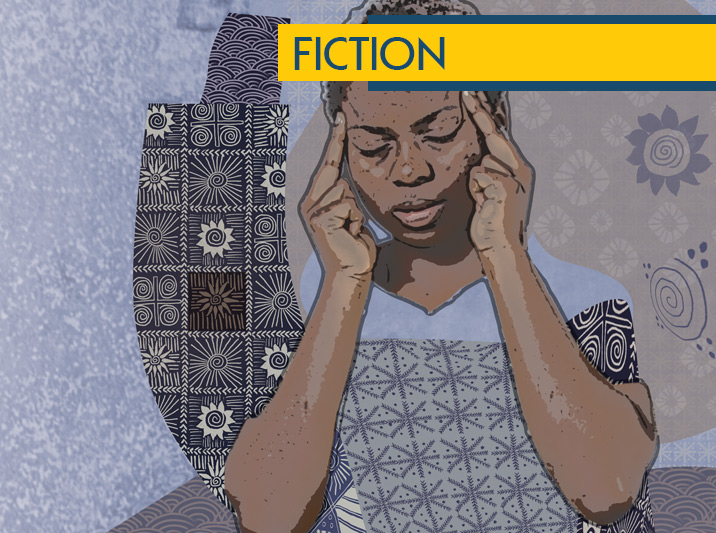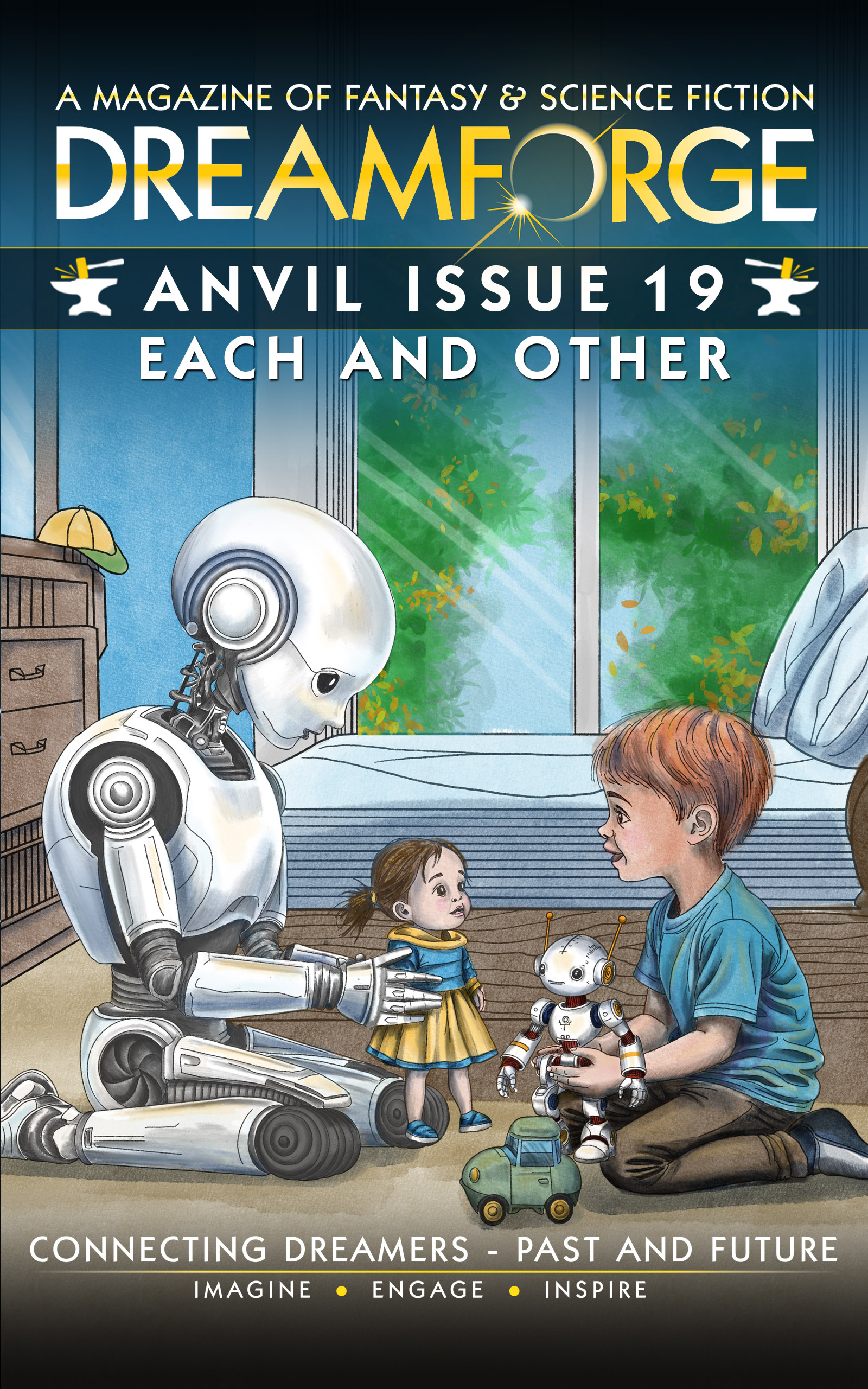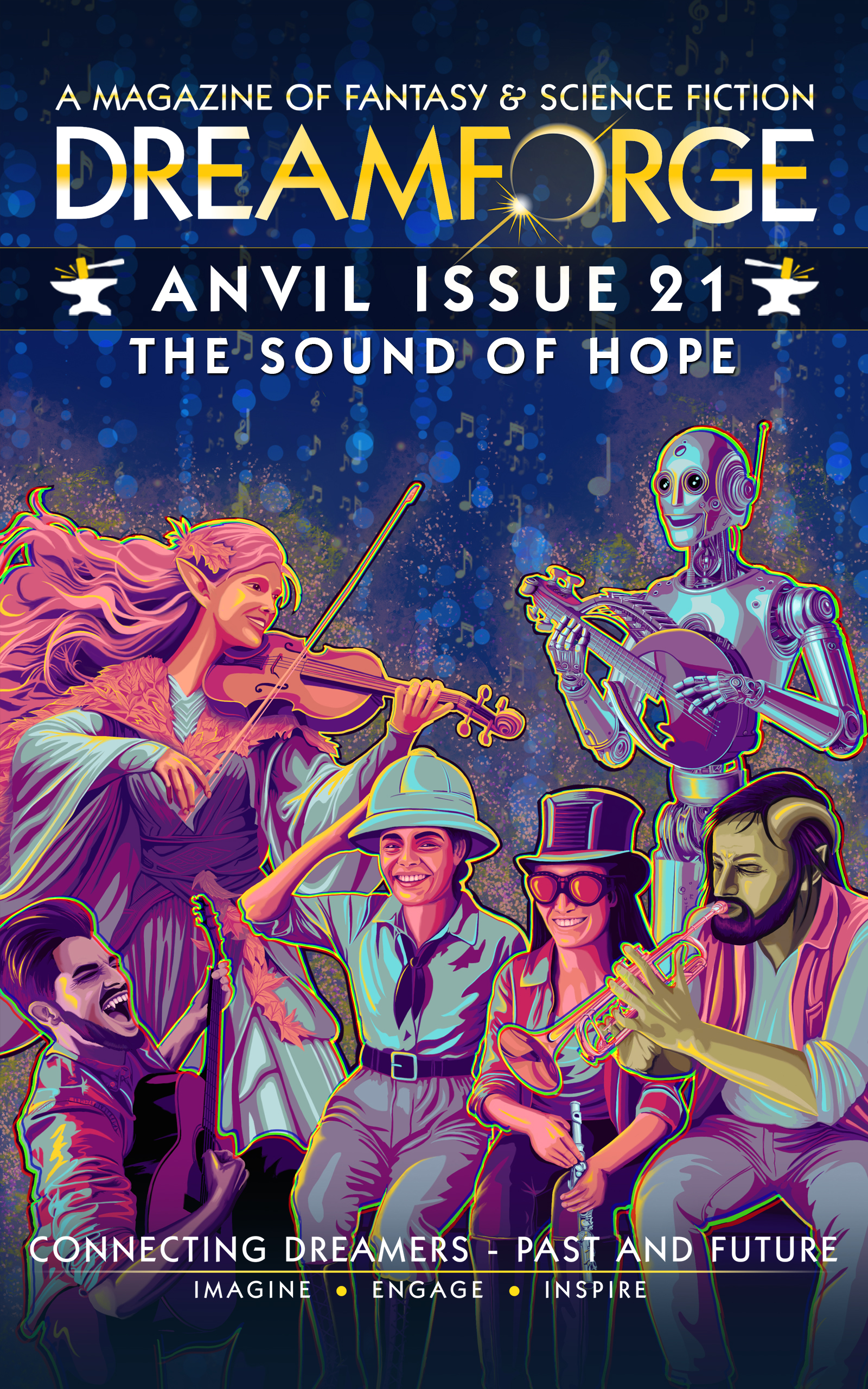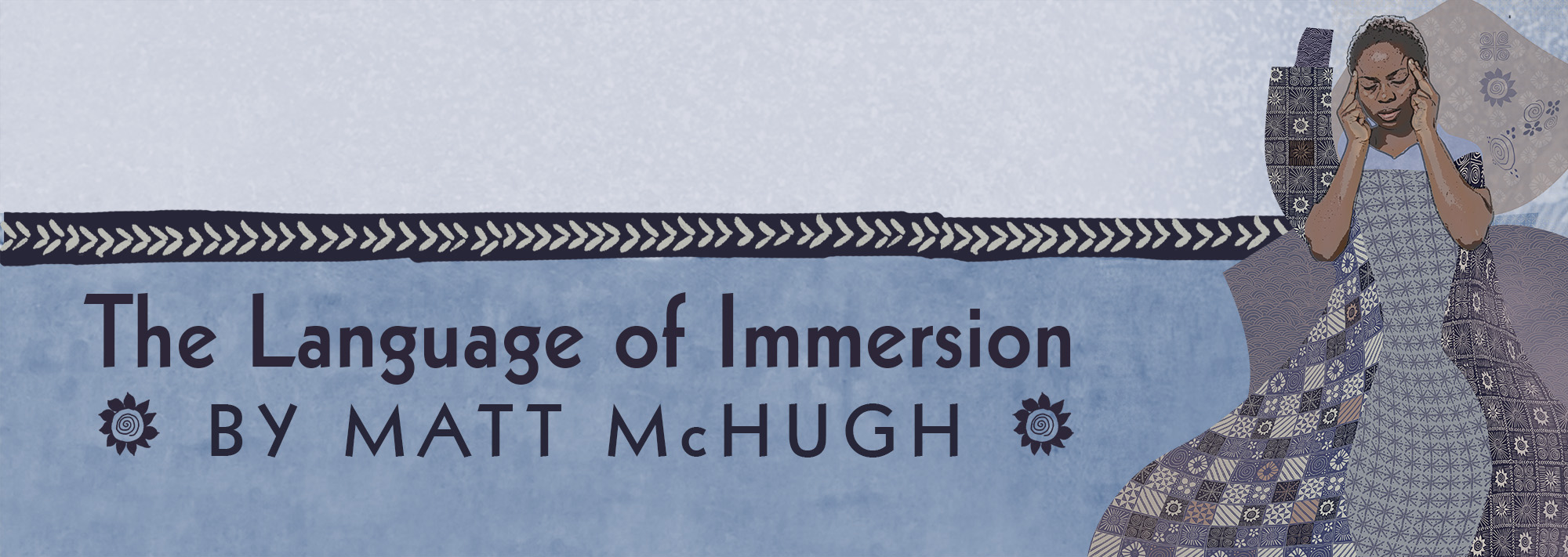
“Good afternoon, Professor Clayton. You wanted to see me?”
“Ah, hello, Ms. Iti. Please. Come in and sit down.”
Ndebe Iti, a student in my multimedia art class, entered my office and took a seat across from my desk. Her transcripts revealed she was on a study visa from Nigeria, and she looked to be in her thirties— a good bit older than the typical undergrad but at least a decade younger than me. Beyond that and the work in her application portfolio, I knew little about her. She was quiet in class, did well enough on assignments, but was behind on the semester project.
“I didn’t get a proposal from you for the final,” I said. “I asked for those last week.”
“I’m sorry. I know I’m late. I will get that to you very soon.”
Her tone was so anxious, I had to try to put her at ease. “It’s OK. That wasn’t mandatory. It’s just to help you stay on track, and let me know if there’s any equipment you need. Some students put in pretty outrageous requests —extra monitors, projectors, controllers— and it can take a while to get things from inter-departmental loan. I want to make sure you have what you need to do what you want.”
“Thank you, but—” she spread her hands, all shyness gone in a burst of frustration, “I don’t know what I want! I’ve been thinking about it, but I have no idea what to do. All this technology… I barely understand any of it! I’m just someone who likes to paint.”
She spoke that final word almost with embarrassment.
“That’s not true,” I countered. “I’ve seen you in the graphics lab. If you can launch an application and open a file, you’re eighty percent there. You have all the skills you need.”
“But everyone else in the class is so far ahead. All the things they do with video and music and animation. They’re all so much better than me.”
“It’s not a competition. You just have to do something that’s yours, that showcases your strengths.” I leaned forward on my desk. “Listen, that class is filled with spoiled rich kids who’ve had laptops and computer camp since they were six. They grew up with this stuff, but —and this does not leave the room— hardly any have a lick of talent. All they know are video games and cartoons. You’ve traveled halfway around the world to go to school in a foreign country. That’s life experience they can’t touch. Do you even have any family here?”
“My husband works at the consulate. And I have a daughter. She just turned eight years old. Idara.”
“So, you’re a wife and a mother,” I said. “And I can tell, simply by how you spoke her name, that you are deeply proud of your daughter. No one else in class knows what that’s like. Show us with your art.”
“I could paint it for you,” she said. “But I have no idea how to turn it into ‘multimedia.’”
I leaned back in my chair. “The first round of student presentations starts this week. Watch them. Ask questions. Take in what they’re good at and fuse it with what you’re good at. Hell, most of them can’t even draw. You’ve got an enormous edge right there. Technically, I need something from you by the last day of the semester. Don’t wait too long, but you have some extra time.”
She nodded. “OK, professor. I appreciate your understanding. I’ll try not to disappoint you.”
After she left, that word lingered with me. Disappoint. Twenty years ago, I was a cocky brat with a freshly minted MFA from this very school who was going to make the art world kneel at my feet. Today, I’m an assistant professor of digital graphics and the only people who look at my work are parents trawling the university website to see if the faculty is good enough for their kid and their money. I understand disappointment very well.
The first presentation was from a girl who built fractals to Mozart. She’d downloaded “Eine kleine Nachtmusik,” converted key notes to numbers, then fed them into a Mandelbrot generator, making complex patterns unfold on screen to visualize the music. It was pretty cool, a little boring after four minutes, but a fine effort.
Next, a guy passed around VR headsets (I had to surrender my driver’s license to sign them out from the library) and showed off a world where you picked up geometric solids —cubes, cones, spheres, octahedrons— then tossed them through glowing rings to trigger drumbeat sounds. There was some lag, but once you got the timing down, you had a carnival game rhythm section. Not bad.
Afterward, as I was packing up the headsets (I wasn’t about to trust overprivileged undergrads to ransom my collateral), I noticed Ms. Iti lavishing the presenters with compliments and questions. Seduced by the flattery, they cracked open their laptops and unfolded their secrets.
Back in my office, I opened Ndebe Iti’s portfolio and scrolled through a dozen paintings. They were mostly of women, lean-limbed figures with dark skin that stood out against bright, stylized backgrounds. Some were made of clean, crisp lines; others emerged from chaotic daubs. Every one, in a hundred subtle ways, radiated longing.
I sat, staring at the paintings on screen. I had quite a few not unlike them in my studio— except all unfinished and none that spoke with a voice as clear. Along with disappointment, the crisis of confidence is a subject where I have substantial expertise.
The next presentation required an eight-foot-wide curved screen and a short-throw projector (don’t even ask what it took to secure those). The class bunched together inside the curve and watched swooping aerial views of fields of digital flowers. An atomizer spritzed the scent of rose and lavender as the perspective soared and dipped. The student proudly cited the amusement park ride it was based on.
This was followed by one utilizing just an ordinary monitor. This clever kid had noticed a building under construction from his dorm window and had set up a time-lapse camera to record the activity for weeks. Night and day wooshed by as workers scrambled over girders like termites, and in just two minutes, eight skeletal-frame stories rose into the skyline, choreographed to chunky techno beats. I know architects who’d pay good money for a sizzle reel like that.
During critique and discussion, one smug fellow piped up, “These were fine traditional works, but mine is going to blow…your…mind.”
Yeah, OK, kid. Sure it will.
I caught up with Ms. Iti in the hallway and coaxed her to the cafe. As we slid into a corner table, I asked, “So what do you think of the presentations so far?”
“They’re amazing. I’m very jealous of them all.”
“I was looking at your entry portfolio the other night,” I said. “And, believe me, they should be jealous of you.”
I wanted to say I’m jealous of you. I did not.
Instead, I said, “Have you seen anything that inspires you?”
“Very much so,” she replied. “But I don’t want to just imitate what other people do.”
“That’s how you become an artist. You see something and say ‘Ooh! I want to do that!’ and you imitate. Eventually you synthesize those influences into something new, something that’s your own. I confess I don’t know much about contemporary African art, but I thought I saw hints of O’Keeffe and Klimt in your work. Am I wrong?”
“I had a postcard of The Lady in Gold on my wall for years. I’ve painted her many times with different tribal patterns in her gown.”
“You mean kente patterns?”
“Kente is from Ghana,” she said. “It’s more colorful. Yoruba is Nigeria. It’s more about the lines and shapes.”
“I didn’t know that. I’ll have to read up. My point is that you put things you love in your paintings, right?”
“When I try to paint things I hate, they look terrible.”
The hint of smile as she sipped her coffee might as well have been a wink. I thought of a morphing animation sequence I produced during my requisite “Angry Young Man” period as a protest to government overreach. Good lord, that sucked.
“So, what made you want to be an artist?” I asked.
“So many things,” she answered. “You were right about Klimt. And Georgia O’Keeffe. My mother had these big books filled with pictures from Van Gogh, Cézanne, Frida Kahlo, on and on. I would get lost in them for hours. They made me love art. Then I learned about all the great Nigerian artists. Ben Enwonwu. Abayomi Barber. Princess Elizabeth Olowu. Afi Ekong. Do you know them?”
I had to shake my head. “No, not really. Email me their names. More to add to my reading list.”
“African artists taught me that I could speak art in my own language,” she said. “Sometimes I look at what I’m doing and think ‘Am I just imitating?’ but the more I do, the less that question matters.”
“It sounds like your journey is well underway. I’m curious to see where it will go.”
“Not to the land of multimedia!” she replied with a nervous laugh. “Seriously, professor, what’s the point of adding movement and sound for its own sake? I’m not saying it’s bad, but shouldn’t the images be enough? Why dress them up with multimedia?”
Because the fine arts faculty was full and this was the only course they’d let me teach.
Because we have no attention span anymore and need to be constantly dazzled.
Because movement and sound obscure mediocrity.
I said none of those things, but instead: “Imagine you whistle a tune. Then you build a song around that tune, with a whole orchestra. Add in singing and dancing. You’ve expanded your idea —created multiple points of entry to it— but in the end, everybody leaves the theater whistling your tune. I don’t know. I just made that up. Does it make any sense?”
“It does,” she said. “You can take something small and expand it to attract attention. But just because something’s bigger doesn’t mean it’s better. Not everything has to be—” she waved her arms and sang out, so loud it silenced conversation and turned heads around the cafe. “TAA-DAAAAH!!”
She clapped a hand over her mouth. “Oops. Sorry. I got carried away.”
It was interesting to see what happened when this quiet woman got carried away.
“No, not everything has to be—” I mimicked her voice and gesture in miniature, “—but it can help something rise above the noise of everyday life. It’s just another language you can speak when you need to.”
She sipped her coffee and knit her brow but said nothing.
“So, more student presentations this week,” I said to fill the silence. “Absorb them. If you were to imitate, what would you copy or change? Most of the equipment will be in the studio for the next two weeks. Your swipe card will get you in anytime, day or night. Play around. Experiment. Just make sure you give me something by the last day of the semester. Please.”
“I’ll try.”
I stayed late again, evaluating project proposals and tweaking the syllabus for next semester. I also had to plow through a gaggle of papers from my Art History 101 class, running the text through A.I. detectors, checking for tell-tale signs of chatbots. It was impressive how much effort students could put in to not learning.
When I was an up-and-coming artist, no one in the world was qualified to teach me a goddamn thing. Then the world handed me a few hard lessons and I became in turn an illustrator, a graphic designer, a video editor, a retail window dresser, a freelance brand image consultant, and—more than once—an itinerant data entry technician. For five years, I’ve been a professor, morosely resigned to nudge the next generation a step closer to a cap-and-gown. What must I seem like to a student who knows my compass points, yet I don’t know hers? At the very least, it shined a harsh spotlight on my lax commitment to learning.
I spent the rest of the evening scrolling through articles about Nok and Benin terracotta figures, Nsibidi iconography and Yoruba indigos, and lost myself in the paintings of Ben Enwonwu and Afi Ekong.
—
Ms. Iti did not show up for the next class, or the following. She missed a slate of run-of-the-mill music video presentations— though one did include quite a bit of hand-drawn animation that must have taken weeks.
I emailed Ms. Iti and got no reply. I waited two days and did so again, with the same result. This surfaced a nagging worry that I had somehow offended her. Every college teacher I know lives in fear of disgruntled students weaponizing indignation as power. Still, end-of-the-semester work took most of my mental energy, so I had no choice but to forge onward.
The next Monday, as students streamed out after the penultimate day of presentations, Ms. Iti came in.
“I need to speak to you, professor,” she said.
Oh, God, I thought. Here it comes.
“I wanted to thank you for everything you’ve tried to do for me,” she said. “I’ve enjoyed your class —it really gave me a lot of new ideas— but I’m going to withdraw.”
“You’re dropping my class?”
She looked down. “I’m leaving the school.”
“Why?”
“My husband doesn’t want to renew his appointment at the embassy. He wants to go back home.”
This caught me off guard. I was surprised and —truth be told— relieved I wasn’t the cause. “I see. Well, if that’s what you want to do, I hope—”
“It’s not what I want!” she blurted. “I want to be a teacher, like you. I want to stay and finish my degree from an American university. Then, when we go home, I can get a teaching certificate anywhere. One more year! Is that so much to ask?”
“There are options,” I said, fumbling. “Assistance plans. Grants. If you want to stay, I’ll do what I can to help you find a way.”
She looked up, jaw tense, eyes fierce but pained. “He’ll take her. He said if I stay, he’ll take Idara with him. A year away from her. He could use that against me. I can’t let that happen. She’s my everything.”
She closed her eyes, clearly fighting tears. In another age, I might have gone over and comforted that young woman, but —for good or ill— that line in the sand had been gouged into a canyon and flooded with molten iron, so I stood, stupid and useless. I filled the uncomfortable silence with banality. “When are you leaving?”
She sniffled, wiped her face. “One month. That’s when his term ends. He’s already started making arrangements.”
In the best of circumstances, giving students life advice is presumptuous, and generally unwelcome even when solicited. What’s worse is that I’ve come to feel unqualified. When I think on my life, I see only missed opportunities— failed half-efforts and aimless wanderings that have brought me back to the starting point, no richer and no wiser. Perhaps, somewhere, there was someone who could justify declaring: Defy your husband, follow your muse! … but that’s not me. Assistant Professor Paul Clayton has planted no flags on the mountaintop of artistic integrity. His only real skill is navigating the valley of bureaucratic process.
Maybe that could be enough.
“You have a month,” I said. “That’s plenty of time to finish your project, receive a passing grade, and secure enough credits to qualify for independent study. You don’t have to be here to finish your degree. The school can do a co-op with the University of Lagos, or anywhere you want. This place loves adding overseas names to the brag list of how—” finger quotes “—global they are. Let’s use that. You can take what you’ve earned here, and transfer that where you need to be. But it all depends on you handing in a project and passing this class.”
“I don’t know if I can do it. I’ve had some ideas from the other students, but nothing feels right. Nothing feels like mine. I need time to immerse myself in the process and see what emerges.”
“You have my blessing to skip class this week and immerse away, as long as, before midnight on Friday, you give me something. You don’t have to present in class. You don’t even have to do it in front of me. I don’t give a shit if you email me a PowerPoint with elevator music. Deliver a multimedia project. Pass this class.”
“I’ll try, professor.”
“Don’t try. Do.”
She snickered. “You sound like Yolo.”
I blinked. “What? YOLO? You only live once?”
“No, no, not Yolo,” she said. “Who’s the little green guy from the movies?”
“You mean Yoda?” Lord forgive me, I did the voice. “Finish what you have begun, you must.”
She gripped an imaginary staff. “Or…YOU SHALL NOT PASS!”
“That’s not Yoda. That’s Gandalf. Not a little green guy. An old white guy.”
“There’s so many of them around, I can’t keep track.”
“Ouch,” I said. “Just make sure you give this one a project by Friday. I’ll look into the requirements for credit transfer and independent study. But I need to log your project as complete to record a final grade. Please. Promise me you’ll turn something in.”
“Alright, professor. I promise.”
To my surprise, Ms. Iti did show up to the Wednesday class. I made eye contact and nodded, but otherwise did not nudge or prod. It was up to her to sink or swim.
After two unremarkable video game-inspired presentations —one was like a futuristic motorcycle race and the other was… dancing origami puzzle shapes, maybe? I don’t freaking know— the blow-your-mind hotshot got up and unpacked something from a foam-padded case. He held up what looked like a swimmer’s cap studded with nubs and trailing a tangle of wires.
“This is a tDSC device,” he explained. “Transcranial direct-current stimulation. You put this on your head, and electrodes activate regions in your brain that trigger emotions. It can also record brain activity and play it back. Grad students in the psychology department are participating in a trial to see how it might help treat conditions like depression and dementia— but today, I’m going to use it to make art. Who wants to try?”
There were no volunteers. College-age kids are supposedly adventurous, but mostly I found them timid, coddled by insular online bubbles that left them terrified of real-world failure or embarrassment. Fortunately, my skin for such things had grown pretty thick.
“I’ll give it a shot,” I said.
There were the expected snickers as I pulled on the snug-fitting cap and tightened the chinstrap. I sat in a chair as the student plugged the trailing wires into a black box. He positioned his laptop in front of me.
“Professor Clayton will now experience not only audio-visual input, but synchronized neuro-electrical stimulation to augment his perception, with the feedback from his brain shaping the progression of sound and images. Behold, the future of immersive media!”
With a dramatic flourish, the student tapped the spacebar. I became aware of a prickling in the back of my head, a dull thud behind my eyes like the last vestige of a hangover. It wasn’t painful, but it wasn’t pleasant. The screen showed a video that flipped between stock footage scenes of war and peace. Goose-stepping armies and marching bands, then laughing children and weeping refugees. More than once, a shrieking skull popped up in ham-fisted jump scares that might have startled me had I not been so distracted by the cicadas buzzing in my skull. I was grateful when it ended.
As I took off the cap, the student watched me with a shit-eating grin and asked, “How was your trip?”
“Interesting,” I said diplomatically, sliding off the cap. “Definite bonus points for originality.” At least for the headgear, I thought. That second-rate montage was pure, puerile pretentiousness.
On Thursday, I monitored the final for my 101 class then gave an open lecture encouraging registration for my Intermediate Digital Design course (so far, only two). The Friday multimedia class is just a gab-session, the projects all done and dusted, and Ndebe Iti is nowhere to be seen. At the end of the day, I’m in my office packing up when I get an email flagged Urgent. It’s from her. Ndebe. She wants me to meet her in the classroom.
It’s empty when I get there. I wait for fifteen minutes and, as I’m just about to leave, she comes bustling in, pushing an overloaded A/V cart.
“I’m sorry I’m so late,” she says. “Do I still have time?”
“Of course,” I answer. “Can I help you set up?”
“I think I can do it.”
She bustles about, fiddling with the projector and display, until at last she plugs in and slides a chair into the valley of the curved screen.
“Can you sit here please, professor.”
I do so. She opens a case and lifts out the electrode headset, its wires dangling like jellyfish tendrils.
“I thought this was cool,” she says. “I don’t know if it will work, but I wanted to try. Do you mind?”
She pantomimes donning the cap, so I pull it on, buckling the chinstrap and steeling myself for the weird skull-buzz. Ndebe draws the window shades, and the room is dark save for the white panorama filling my peripheral vision.
The screen displays a grid where colored shapes drift over each other until they lock into place. Words appear (HOUSE, CAR, TREE, CAT), paired with images, sometimes mismatched. The same with a few simple math problems (1+1=2 … 2+2=5). After a minute or so, a pop-up winks on: Calibration Successful. Nedbe clicks OK and the screen again goes blank.
The empty span fills me with a quiet thrill, anxiety and anticipation equally blended. I hear a sweet, soulful melody and pencil marks dance across the canvas, coalescing into a sketch. I see a door, a window, a person, another person. I don’t recognize them, yet I know them.
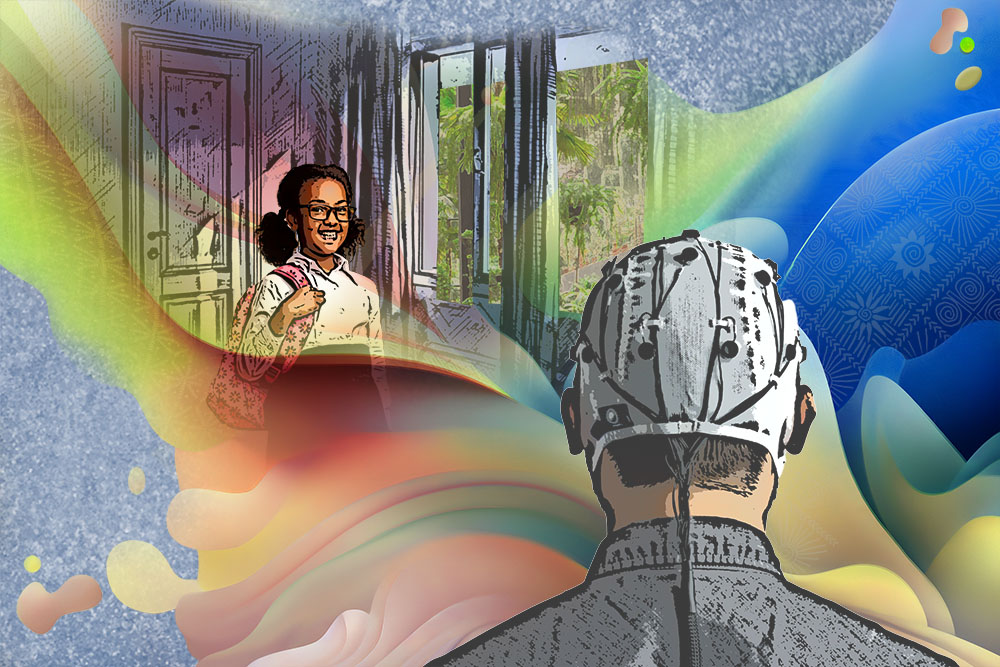
Waves of color begin to flow —emerald, ivory, citrine, and ebony— glinting with cadmium, manganese, titanium, and zinc. A scent of orange, sharp as freshly pierced zest, blossoms from the music and blends with the colors. The painted door is closed, nestled in a wall that assumes the grit of plaster. Through the window, morning light gilds the edges of buildings, but the glass and girders warp until they are more forest than city. A young girl materializes before the door. She wears a school uniform, a costume that hides her uniqueness, a suit of armor that offers the barest protection. Her pink flowered backpack is a jolt of joy she gives to the world. Her brown face still has the soft curves of childhood, but the tight jawline hints at the coming angles of age.
She reaches one hand toward the door handle —ready to venture into the forest-city— while her other hand hangs at her side, thumb and forefinger gripping a doll by the hem of its sleeve. She needs only to open her fingers a fraction and the doll will drop away. I desperately want her to hold it, to hold her innocence, just a little longer. Please. Just a little longer.
Stretching to the left is a hallway leading to a room where a man stands beside a desk. It is night in that room. It is always night with him. A single lamp, electric but with the withering glow of flame, envelopes him in a bubble of light. The folds in his crisp white shirt wrap him in a valley of shadows. From the storm of papers on his desk, he has taken one. His thumb and forefinger pinch the short, graying strands of his beard as he stares intensely at the paper. In this moment, nothing exists for him but the secrets on that paper. I can almost read the words reflected in his glasses. I’m afraid of what they might say.
He is a man of serious mind, the righteousness simmering behind his stern expression commands respect. But love? Love has become hidden by the shadows.
The man and the girl exist at the ends of a long plank, a teeter-totter where I hold the center and struggle to balance. How foolish I was once, to believe I could hold that center forever. I know I will have to let go— let go and hope I have done enough.
Everything goes still and quiet.
Lights come on.
I’m sitting in a classroom, looking at a painting projected on a screen, a bumpy cap fastened onto my head.
“Did it work?” asks Ndebe.
I gasp, waking from a dream, slowly remembering who and what I am.
Ndebe leans down and squints with concern. “Are you alright?”
I feel my face. Tears are streaming down my cheeks. “What happened?”
“I painted that last night,” she says pointing to the screen. “I filmed it in time-lapse— there’s an app you can get for your phone to do it—then played it back. I’m sorry it was so short.”
I look at the clock. Barely three minutes have gone by. If you told me it was hours, I would have believed you.
I touch the cap on my head. “What about this?”
“I wore it while I was painting and set it to record. I didn’t feel anything, so I thought it didn’t work. Did you feel something?”
“I felt everything,” I say, overwhelmed, struggling to get the words out. “Every brushstroke. I saw it as you see it. I was there. I was you. How did you do that? This cap thing was useless during that other guy’s presentation.”
“He didn’t read the instructions,” she replies. “There’s a calibration program you have to run for each new user, each new brain. That was the first part with the lines and numbers.”
“I heard music,” I say. “I smelled oranges. Was that real?”
“There’s a citrus oil brush cleaner I always use, so I put some in the atomizer. The music was a korba player from Gambia. I listen to her songs when I paint, so I played one over the video. I wanted to share the sounds and smells I experience when I work.”
“You took a piece from each presentation,” I say. “You imitated the other students, then added something to make it your own.”
Ndebe frowns, answers almost defensively. “That’s what you told me to do. So, is it enough? Do I pass and qualify for independent study?”
I stand up, still a bit shaky. I take off the cap and hold it in my trembling hands, reeling at the implications.
The power to bridge the gap between creator and observer. Empathy, perfect emotional empathy, neuro-electrically induced. I realize I have just witnessed something few are privileged to behold in their lifetime: the birth of a new art form.
“What you did,” I say to her. “How you put it all together. For your independent study, would you be willing to teach it to other students?” I pause, then tap my chest. “And to me.”
I need no device, no electronic assistance, to understand what she is feeling as a smile rounds the curve of her jawline.
“I would love to do that, professor.”


